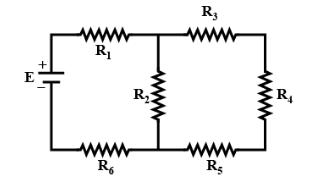
In the figure shown, what is the current (in Ampere) drawn from the battery? You are given:
${R_1} = 15\Omega, {R_2} = 10\Omega, {R_3} = 20\Omega, {R_4} = 5\Omega, {R_5} = 25\Omega, {R_6} = 30\Omega, E = 16V$
A. $\dfrac{7}{18}$
B. $\dfrac{13}{24}$
C. $\dfrac{9}{32}$
D. $\dfrac{20}{3}$


Answer
579.3k+ views
Hint: The equivalent resistance in a series combination of n resistors is given by ${R_{eq}} = {R_1} + {R_2} + {R_3} + ..... + {R_n}$
The equivalent resistance in a series combination of n resistors is given by $\dfrac{1}{{{R_{eq}}}} = \dfrac{1}{{{R_1}}} + \dfrac{1}{{{R_2}}} + \dfrac{1}{{{R_3}}} + ..... + \dfrac{1}{{{R_n}}}$
Total current in circuit is given by $I = \dfrac{E}{{{R_{eq}}}}$ where $E$ is the emf of the battery source and ${R_{eq}}$ of the circuit.
Complete step by step solution:
As from the figure it is clear that ${R_3},{R_4},{R_5}$ are in series and we know that the equivalent resistance in a series combination of n resistors is given by ${R_{eq}} = {R_1} + {R_2} + {R_3} + ..... + {R_n}$
Let $X$ be the equivalent resistance of ${R_3},{R_4},{R_5}$ .
So, $X = 20 + 5 + 25 = 50\Omega $
Now, $X$ and ${R_2}$ is in parallel and we know that the equivalent resistance in a series combination of n resistors is given by $\dfrac{1}{{{R_{eq}}}} = \dfrac{1}{{{R_1}}} + \dfrac{1}{{{R_2}}} + \dfrac{1}{{{R_3}}} + ..... + \dfrac{1}{{{R_n}}}$
Let $Y$ be the equivalent resistance of $X$ and ${R_2}$
Then, $\dfrac{1}{Y} = \dfrac{1}{X} + \dfrac{1}{{{R_2}}} = \dfrac{1}{{50}} + \dfrac{1}{{10}}$
On simplification, we get $Y = \dfrac{{25}}{3}$
Now, ${R_1},Y,{R_6}$ will be in parallel.
So, the total equivalent resistance of the circuit, ${R_{eq}} = {R_1} + Y + {R_6} = 15 + \dfrac{{25}}{3} + 30$
On simplifying we have ${R_{eq}} = \dfrac{{160}}{3}$
As we know that total current in the circuit is given by $I = \dfrac{E}{{{R_{eq}}}}$ where $E$ is the emf of the battery source and ${R_{eq}}$ of the circuit. This relation is derived from Ohm’s law.
It is given in the question that emf $E = 15V$
So, the current drawn from the battery is $I = \dfrac{{15 \times 3}}{{160}} = \dfrac{9}{{32}}amp$.
$\therefore$ So, the current drawn from the battery is $I = \dfrac{9}{{32}}amp$. Hence, option (C) is the correct answer.
Note:
Ohm’s principal discovery was that the amount of electric current through a metal conductor in a circuit is directly proportional to the voltage impressed across it, for any given temperature. Ohm expressed his discovery in the form of a simple equation, describing how voltage, current, and resistance interrelate:
$E = IR$ where $E$ is the emf of the battery source, $I$ is the current and $R$ is the resistance.
The equivalent resistance in a series combination of n resistors is given by $\dfrac{1}{{{R_{eq}}}} = \dfrac{1}{{{R_1}}} + \dfrac{1}{{{R_2}}} + \dfrac{1}{{{R_3}}} + ..... + \dfrac{1}{{{R_n}}}$
Total current in circuit is given by $I = \dfrac{E}{{{R_{eq}}}}$ where $E$ is the emf of the battery source and ${R_{eq}}$ of the circuit.
Complete step by step solution:
As from the figure it is clear that ${R_3},{R_4},{R_5}$ are in series and we know that the equivalent resistance in a series combination of n resistors is given by ${R_{eq}} = {R_1} + {R_2} + {R_3} + ..... + {R_n}$
Let $X$ be the equivalent resistance of ${R_3},{R_4},{R_5}$ .
So, $X = 20 + 5 + 25 = 50\Omega $
Now, $X$ and ${R_2}$ is in parallel and we know that the equivalent resistance in a series combination of n resistors is given by $\dfrac{1}{{{R_{eq}}}} = \dfrac{1}{{{R_1}}} + \dfrac{1}{{{R_2}}} + \dfrac{1}{{{R_3}}} + ..... + \dfrac{1}{{{R_n}}}$
Let $Y$ be the equivalent resistance of $X$ and ${R_2}$
Then, $\dfrac{1}{Y} = \dfrac{1}{X} + \dfrac{1}{{{R_2}}} = \dfrac{1}{{50}} + \dfrac{1}{{10}}$
On simplification, we get $Y = \dfrac{{25}}{3}$
Now, ${R_1},Y,{R_6}$ will be in parallel.
So, the total equivalent resistance of the circuit, ${R_{eq}} = {R_1} + Y + {R_6} = 15 + \dfrac{{25}}{3} + 30$
On simplifying we have ${R_{eq}} = \dfrac{{160}}{3}$
As we know that total current in the circuit is given by $I = \dfrac{E}{{{R_{eq}}}}$ where $E$ is the emf of the battery source and ${R_{eq}}$ of the circuit. This relation is derived from Ohm’s law.
It is given in the question that emf $E = 15V$
So, the current drawn from the battery is $I = \dfrac{{15 \times 3}}{{160}} = \dfrac{9}{{32}}amp$.
$\therefore$ So, the current drawn from the battery is $I = \dfrac{9}{{32}}amp$. Hence, option (C) is the correct answer.
Note:
Ohm’s principal discovery was that the amount of electric current through a metal conductor in a circuit is directly proportional to the voltage impressed across it, for any given temperature. Ohm expressed his discovery in the form of a simple equation, describing how voltage, current, and resistance interrelate:
$E = IR$ where $E$ is the emf of the battery source, $I$ is the current and $R$ is the resistance.
Recently Updated Pages
A man running at a speed 5 ms is viewed in the side class 12 physics CBSE

The number of solutions in x in 02pi for which sqrt class 12 maths CBSE

State and explain Hardy Weinbergs Principle class 12 biology CBSE

Write any two methods of preparation of phenol Give class 12 chemistry CBSE

Which of the following statements is wrong a Amnion class 12 biology CBSE

Differentiate between action potential and resting class 12 biology CBSE

Trending doubts
What are the major means of transport Explain each class 12 social science CBSE

Which are the Top 10 Largest Countries of the World?

Draw a labelled sketch of the human eye class 12 physics CBSE

How much time does it take to bleed after eating p class 12 biology CBSE

Explain sex determination in humans with line diag class 12 biology CBSE

Explain sex determination in humans with the help of class 12 biology CBSE




